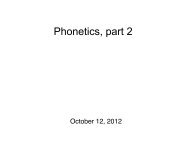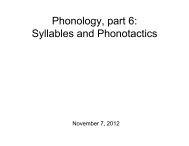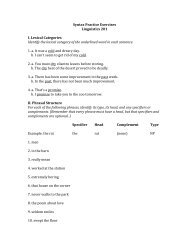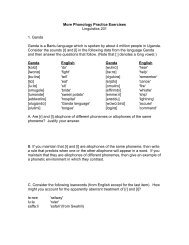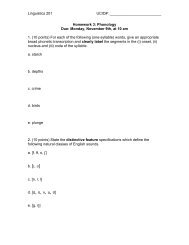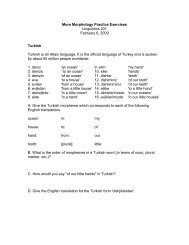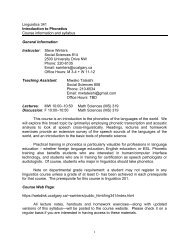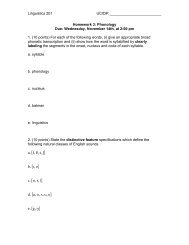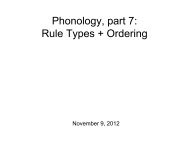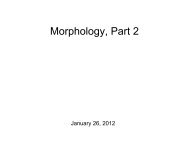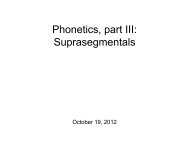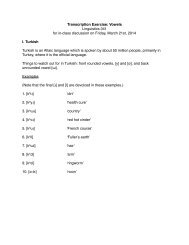Phonology - Basesproduced.com
Phonology - Basesproduced.com
Phonology - Basesproduced.com
Create successful ePaper yourself
Turn your PDF publications into a flip-book with our unique Google optimized e-Paper software.
<strong>Phonology</strong>October 25, 2010
• To begin with...Today’s Plan• Phonetics homeworks to hand in!• Then:• Another Simpsons-based Quick Write• Today: <strong>Phonology</strong>• Wednesday: review for mid-term.• Friday: mid-term!• Note: we will be splitting up into three separate rooms forthe mid-term. (more details to <strong>com</strong>e on Wednesday)
<strong>Phonology</strong>• The study of how the pronunciation of sounds changesaccording to context is called phonology.• We have already seen some phonological changes withrespect to the phoneme /t/.• English /t/Word Broad Narrow Description‘top’aspirated‘stop’‘batter’‘kitten’unaspiratedflappedglottalized‘nitrate’ /najtrejt/ palatalized
Phonemes and Allophones• Recall: the basic idea behind the IPA is to have onesymbol for each sound.• Principle of Contrast:• “There should be a separate letter for eachdistinctive sound; that is, for each sound which,being used instead of another, in the samelanguage, can change the meaning of the word.”• Phonemes contrast with each other; they are“distinctive sounds”• Allophones do not contrast with each other;• They cannot distinguish between words.
Phonemes and Allophones• For example--[t] and [d] are two different sounds(phonemes) in English;• they can change the meaning of a word--tip vs. dip ~ [t] vs. [d] ~ pat vs. pad• Remember: two words that differ in only one soundare called a minimal pair.• However, there is no minimal pair in Englishdistinguished by a flap vs. a voiceless stop.• Canadian English: “bottom”• British English: “bottom”
Wait a second…• Sounds that are distinctive, or contrast, in one language,are not necessarily distinctive in another.• Ex: [s] andare distinctive in English.sheep vs. seepshack vs. sackshoot vs. suitmash vs. massetc.• But they are not distinctive in Japanese…
Some Japanese Words‘this year’‘outside’‘a little’ ‘to know’‘world’‘sugar’‘to do’‘to force/cause’• Q: What’s the pattern?• A: appears before [i]: ____ [i]• [s] appears elsewhere• There are no minimal pairs forand [s] in Japanese.⇒ In Japanese, they are not contrastive sounds.
Biblical Parallels“And the Gileadites took the fords of the Jordan against theEphraimites. And when any of the fugitives of Ephraim said,‘Let me go over,’ the men of Gilead said to him, ‘Are you anEphraimite?’ When he said, ‘No,’ they said to him, ‘Thensay Shibboleth,’ and he said, ‘Sibboleth,’ for he could notpronounce it right; then they seized him and slew him at thefords of the Jordan.”--Judges 12:5-6
Modern-day Shibboleths“house”“howl”“bike”“bile”(Canadian) Jon(American) Steve• Also note (Canadian) Amber:
Modern-day Shibboleths• Canadian English is distinctive in that it “raises” the firstpart of the diphthongs [aj] and [aw].• In both cases, [a] →[aj] →[aw] →• This is “raising” because a low vowel be<strong>com</strong>es amid vowel.• Technical term: Canadian Raising.
Canadian Raising• Canadian Raising only occurs in certain soundenvironments:• “house”• “write”• “pipe”“loud”“ride”“bribe”• “like”• Q: When does Canadian Raising occur?• (what is the relevant sound environment?)• A: [aj] and [aw] “raise” whenever they appear beforea voiceless consonant.
Another Pattern• Here’s one that we’ve seen before:[p h æt] ‘pat’ [spæt] ‘spat’[t h ap] ‘top’ [stap] ‘stop’[k h ar] ‘car’ [skar] ‘scar’• Voiceless stops are aspirated when they appear at thestart of a stressed syllable.• Unless they appear immediately after s: s___• Because aspirated and unaspirated stops don’t appear inthe same phonetic environment in English….• They are not contrastive sounds.
However…• In languages like Quechua, there are meaningful contrastsbetween aspirated and unaspirated stops and affricates.• Some minimal pairs:
Different Levels• In all languages, there are sounds which contrast.• They make meaningful differences between words.• = “phonemes”• Phonemes also have variants which do not contrast.• …but reliably appear in particular phoneticenvironments.• = “allophones”• Phonemes represent abstract, psychological reality• broad transcriptions• allophones represent concrete, physical reality.• narrow transcriptions
Big Picture Flashback• Knowing how the broad level of transcription relates to thenarrow level of transcription is part of what you know as a<strong>com</strong>petent speaker of a language.• = knowing which allophone to use for a particularphoneme, in some particular circumstance.• Another word for this knowledge is phonology.• This is subconscious knowledge• This knowledge takes the form of rules…• For that reason, it can apply to new, creative forms.• Try, for example, nonsense words like “mowch” or “skype”.
Example Rule• In Japanese, [s] andphoneme.Phoneme:are allophones of the same/s/Allophones:[s]• Observations:• appears only in front of /i/• [s] appears everywhere else• Rule: /s/ surfaces as in front of /i/• Speakers of Japanese “know” this rule
Phonological Rules, formalized• Phonological rules can be written in the following form:/Phoneme/ → [Allophone] / Environment• The environment is where we see the phonologicaltransformation taking place.• Usually, the phonetic environment consists of thesounds surrounding the phoneme in question.• Example rule (Japanese):/s/ → / __ [i](__ [i] = before an [i])
Distributions• Question:How do we know that the /s/ changes to anJapanese, and not the other way around?in• We have to take into consideration the distribution ofthe two sounds.• The distribution is the set of phonetic environments inwhich a sound appears.• Two kinds of distributions:• contrastive• <strong>com</strong>plementary
Contrastive Distribution• Two sounds are in contrastive distribution when theycan both appear in the same phonetic environment.• Sounds that change the meaning of words in a minimalpair are in contrastive distribution.• (Because they contrast with each other)•Example:‘bit’ vs. ‘pit’ [bIt] vs. [p h It]⇒ [b] and [p h ] belong to different phonemes• Note the distribution:• the sounds surrounding [b] and [p h ] in this example areexactly the same.
Complementary Distribution• When sounds are in <strong>com</strong>plementary distribution, theynever appear in the same phonetic environment.
Complementary Distribution• When sounds are in <strong>com</strong>plementary distribution, theynever appear in the same phonetic environment.all possiblephoneticenvironmentssound 1 appears inthese environmentssound 2 appears inthese environments
Complementary Distribution• When sounds are in <strong>com</strong>plementary distribution, theynever appear in the same phonetic environment.all possiblephoneticenvironmentsthere is no overlap in where the two sounds appear
• [s] andExamplesare in <strong>com</strong>plementary distribution in Japanese• appears before the vowel [i]• [s] never appears before [i], but it appears mosteverywhere else• [t h ] and [t] are in <strong>com</strong>plementary distribution in English• [t] appears after the consonant [s], and at the end ofsyllables• [t h ] appears at the beginning of stressed syllables, butnever after [s]• Sounds that are in <strong>com</strong>plementary distribution aregenerally allophones of the same phoneme
Types of Allophones• A restricted allophone is one that appears in only alimited set of phonetic environments.• in Japanese (only before [i])• [t] in English (only after [s])• A basic allophone is one that appears in a lessrestricted set of environments.• The basic allophone is also supposed to represent thephoneme in speakers’ heads.• [s] in Japanese(phoneme = /s/)
More Japanese Words• What is the distribution of [h], [ç] and [f] in the followingJapanese words?([ç] is a voiceless palatal fricative)[çito] ‘person’ [haha] ‘mother’[çifu] ‘skin’ [asaçi] ‘morning sun’[heta] ‘awkward’ [fune] ‘ship’[hon] ‘book’ [ha∫i] ‘chopsticks’[fuhenfuto:]‘neutrality’• Q: Are they in <strong>com</strong>plementary or contrastive distribution?
Some Rules• In Japanese,[h] appears before [a], [o], and [e][f] appears before [u][ç] appears before [i]• Q: Which is the basic allophone, and which arerestricted?• [h] is the basic allophone; [f] and [ç] are the derivedallophones.• Two phonological rules account for the distribution:/h/ → [f] / ___ [u]/h/ → [ç] / ___ [i]



